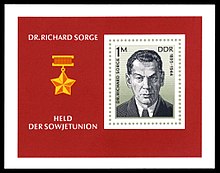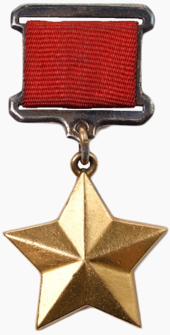Hero of the Soviet Union
Hero of the Soviet Union ( Russian Герой Советского Союза , scientific transliteration Geroj Sovetskogo Sojuza ) was the highest honor and honorary title that was awarded in the USSR for “personal and collective merits for the state and society of the Soviet Union”. It was donated in 1934 to honor the rescuers of the Chelyuskin occupation .
The award included at Foundation on April 16, 1934
- the award of the Order of Lenin and
- a certificate from the Presidium of the Supreme Soviet
- a one-time grant equal to an annual salary.
From August 1, 1939, the award also included the award of the “Golden Star” medal.
The first heroes of the Soviet Union in 1934 were the so-called Tscheljuskinzy , seven pilots who had made a name for themselves in a spectacular rescue of shipwrecked people. The entire crew of the Chelyuskin, which was trapped by the pack ice on an expedition through the Arctic Ocean after the sinking of their ship, was rescued from an ice floe. On the occasion of this rescue, the title was founded on April 16, 1934 by resolution of the Central Committee of the CPSU and was first awarded on April 20, 1934.
Hero of the Soviet Union and the Order of Lenin
Until the title Hero of the Soviet Union was established, the Order of Lenin was the highest state distinction in the Soviet Union. Immediately after the introduction of the new title, the question arose as to how the title Hero of the Soviet Union, now the highest distinction, could also be externally distinguished from the Order of Lenin. With the foundation of the Golden Star on August 1, 1939 in addition to the Order of Lenin, the title Hero of the Soviet Union received this unique selling point as the highest distinction. Initially, from 1939 onwards, the Order of Lenin was only allowed to be presented for the first golden star (i.e. once). In subsequent multiple awards of the title Hero of the Soviet Union from 1972 onwards, the Order of Lenin was allowed to be awarded again (decree of the Presidium of the Supreme Soviet in the 1973 version). Overall, the reputation of the award was devalued by multiple awards to high-ranking politicians.
For the second award of the title, a bronze bust of the hero was placed in the hometown of the recipient or, by decision of the Presidium of the Supreme Soviet, at another location.
golden Star

The medal was a five-pointed gold star with a smooth obverse . On the lapel there was the inscription " Герой СССР " (Hero of the USSR) and the award number. The strap of the lanyard was red.
In total, the title was awarded to 12,600 people by the beginning of 1986, over 11,000 of whom were honored in the years of the Second World War alone . So far there have been 150 awards twice, three times to three people and four times to two people. The Deputy Supreme Commander of the Red Army in World War II, Marshal Zhukov , and the later party leader of the CPSU Leonid Brezhnev received four awards each . The award was given three times to the flying heroes Marshal of the Aviators Alexander Pokryschkin and Marshal of the Aviators Ivan Koschedub , as well as Marshal of the Soviet Union Budjonny . A total of 11,664 medals were awarded.
Even under Nikita Khrushchev a certain inflation of this title set in, as he not only awarded it for extraordinary deeds, but also on special birthdays. Zhukov got his fourth title for his 60th birthday, Budjonny got all three titles for milestone anniversaries. Brezhnev received all four awards (December 18, 1966, December 19, 1976, December 19, 1978 and December 18, 1981) on the occasion of his birthday when he was General Secretary of the CPSU. This inflationary allocation practice was abolished by the Supreme Soviet in 1988. Khrushchev also awarded the title as reparation to people who were unjustly forgotten or accused of traitors to the country.
"Heroic deeds" for which the title was awarded included the suppression of the 1956 uprising in Hungary by Zhukov or the assassination of Trotsky . His murderer Ramón Mercader was named Hero of the Soviet Union by Stalin in 1940 . U-boat commanders like Alexander Iwanowitsch Marinesko ( S-13 ) and Wladimir Konstantinowitsch Konovalov ( L-3 ) also received this award for sinking German ships towards the end of the Second World War. Marinesko received the title posthumously in 1990 after it had previously been denied.
The Germans Fritz Schmenkel and Richard Sorge were also named Heroes of the Soviet Union.
In 1992 Boris Yeltsin created the title Hero of the Russian Federation (Герой Российской Федерации Geroj Rossijskoj Federacii ) with a corresponding star, which replaced the old title of the dissolved Soviet Union.
See also
- List of Heroes of the Soviet Union
- Hero of the GDR
- Hero of Ukraine
- Hero of Belarus
- Hero of the Russian Federation
Web links
Individual evidence
- ↑ Star from the bottom of the barrel: The last hero of the Soviet Union lives in St. Petersburg , In: Sankt-Peterburgskije Vedomisti (April 16, 2009)
